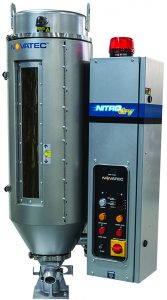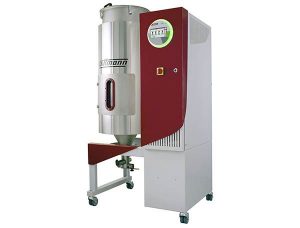
Canada dry
Canadian Plastics
Plastics Processes Raw Materials HandlingThe infamous Canadian humidex signals danger to resins, which will all absorb at least some moisture if left unprotected. Which is why keeping them dry is the best defense. These latest technologies are up to the challenge.
There are boatloads of Canadian inventions we can be proud of: hockey, the telephone, and poutine are three celebrated examples. More dubious is the humidex. The term – short for humidity index – is a Canadian innovation first used in 1965, and coined for a very good reason: On the stickiness scale, some areas of Canada can feel more like the Amazon rainforest than the Great White North, especially during summer. For years, Southern Ontario earned the reputation as the humidex capital of Canada, with Quebec not far behind. And because these two epicentres of sweatiness are also the main plastics processing regions in Canada, it’s no mystery why effective resin drying is at a premium here, since all resins will absorb at least some moisture, leading to long-term loss in mechanical properties…and maybe a loss in business.
The good news? In the long-running war against moisture absorption, victory isn’t coming – it’s here. These latest drying technologies can help you to turn the tide right now. Forewarned is forearmed.
PORTABLE AND INTUITIVE
A newer generation of Conair Group’s Carousel Plus desiccant dryers – D series portable dryers and dX series mobile drying/conveying systems – are designed to offer superior resin drying performance together with advanced yet easy-to-use controls, high reliability and energy efficiency, and an innovative new air-to-air aftercooling option. The new dryers are based on a top-to bottom redesign of the Carousel Plus desiccant dryer architecture affecting portable dryers and mobile drying/conveying systems sized from 15 to 400 lbs per hour of throughput. “The new D and dX series dryers combine a new control interface with extremely reliable components that maximize performance, uptime, and energy efficiency,” said Alan Landers, Conair’s dryers product manager. “These are housed in a new, space-efficient chassis that saves floor space and offers easier, more direct access to key components and to user-serviceable items like filters.” Additionally, customers can specify dryers equipped with either an optional air-to-water aftercooler or the new air-to-air aftercooler; the air-to-air unit can sustain drying efficiency while handling return-air temperatures of up to 375°F (190°C), and dewpoints of -40°F (-40°C). “The air-to-air option also saves water, maximizes dryer portability, and makes installation and set-up faster and easier,” Landers said. Finally, the dryers use a new DC-C programmable electronic controller, which was developed specifically for drying applications. “The control uses software developed by Conair to maximize flexibility in adapting to current and future customer application needs,” Landers said.
Tapping into Industry 4.0 buzz, DriAir Industries Inc. recently launched its Dri-Air Dryer 4.0, which uses internet capabilities to adjust to conditions and changes in the operation autonomously, gathering information and adapting on its own. For customers with multiple systems, a central dryer control can be installed that displays each dryer’s operating parameters and other important data. When a dryer needs servicing, an icon flashes to show what needs to be done, with directions for service and the parts required. The dryer’s control monitors motor performance, reporting this data to the main control. By using 4.0 wireless technology, the molder can compare cycle times among dryers, molding machines, and robots to determine the optimum cycle for the equipment. Dri-Air Dryer 4.0 also incorporates cyclonic removal of fines coupled with a visible collector of waste that notifies the customer’s maintenance team when it’s full, virtually eliminating filtration cartridges. As a new Dri-Air 4.0 dryer is installed, it’s automatically added to the group display, and the list of spare parts required is updated. An inventory package that tracks and stores the spare parts is currently under development.
A new intermediate-range model in Maguire Products’ VBD line of vacuum resin dryers expands the throughput capacity of these systems and also introduces an energy monitoring capability that the company will make available on all VBD models. “The VBD 600 dryer handles throughputs up to 600 lbs per hour, building out the VBD lineup and joining the VBD 150, VBD 300, and VBD 1000,” said Brian Davis, president of Maguire Products Canada Inc. “Maguire’s vacuum drying systems now have throughput capabilities ranging from 30 to 1,000 lbs per hour.” A new controller display on the VBD 600 dryer monitors energy consumption and enables processors to track usage over time. In the VBD series, gravity moves material through three vertically arranged drying stages – heating hopper, vacuum vessel, and material retention hopper – with material discharge to each stage controlled by high-speed slide gate valves boasting accuracy of ± four grams. The vacuum vessel and retention hopper are mounted on load cells that monitor the weight of material at these stages, controlling material consumption and documenting process conditions for certification to customers. For hygroscopic materials, a membrane purge option is available.
CONTROLLING TENDENCIES
Combined functions – drying and conveying – are the emphasis for Motan Inc. with its new Luxor E A and Luxor EM A mobile dehumidifying dryers for small throughputs or standalone applications, which can provide 60 to 150 litres of drying hopper volume. Luxor E A models can be integrated into existing conveying systems or equipped with a standalone material loader. Luxor EM A dryers with integrated conveying are self-contained mobile units. As standard, they have integrated drying and a side channel blower, as well as a small, monitored cyclone dust collection filter and bin. The Luxor EM A can control up to three Metro G material loaders – one to supply the drying hopper and up to two more to supply processing machines. Optionally, Metro G loaders can be equipped with a Metromix proportioning valve, so that any regrind produced at the machine can be immediately returned to the production process. The dryers operate in a closed process in combination with temperature controlled regeneration, and also have an option for dewpoint controlled regeneration. Both dryer ranges come standard with the new LuxornetEM colour touchscreen control.

Novatec’s NitroDry press-side resin dryer is targeted at sensitive resins. Photo Credit: Novatec
Novatec Inc.’s new NitroDry pressside resin dryer is targeted at sensitive resins, especially nylons, polyurethanes, and PLA, which are highly susceptible to oxygen degradation from prolonged exposure to heat in the presence of oxygen. The degradation can impact strength, ductility, colour, viscosity, chemical resistance, stiffness, and stability. Traditionally, the problem was solved by using nitrogen to displace oxygen in the drying hopper, but nitrogen dryers usually require an external source for the nitrogen – often bulky tanks of the gas. By contrast, NitroDry generates its own nitrogen using standard factory compressed air as a feedstock, and it vents air to the drying room. It also removes the danger of releasing a large quantity of pure nitrogen into the air, because the gas is produced only at the rate at which it’s needed. According to Mark Haynie, Novatec’s product manager for dryers, the technology is exclusive to Novatec and falls under the umbrella of the NovaDrier compressed air/membrane system patent. The NitroDry system comes with a five-year warranty, and is initially being made available in models with throughputs of 7, 25, and 50 lbs per hour.
MOVING AND LINKING
Universal Dynamics, a Piovan SpA brand and the maker of the Genesys PET resin drying system, plans to more than double its production over the next three years by moving to a new North American headquarters in Fredericksburg, Va. by the end of this year, and begin to roll out new product lines by next year. The company budgeted US$10 million for the purchase, renovation, and expansion of the 88,000-square-foot building. UnaDyn’s previous headquarters was in Woodbridge, Va. The new highly automated “fresh slate” factory will allow the company to streamline component manufacturing, fabrication, welding, preassembly, and final assembly of auxiliary equipment, including dryers. The Genesys dryer, said to be the only auto-adaptive system available today, uses a variety of technologies – including loss-in-weight control, airflow management and stabilization, an intelligent regeneration process, and advanced industrial PC-based control – to ensure that highly hygroscopic PET resin doesn’t experience a rapid drop-off in intrinsic viscosity, which can be detrimental to the blow molding process of PET containers. And by integrating an automatic airflow control and adjustment to reduce energy consumption – coupled with the capability to stabilise the airflow in the drying hopper – Genesys is able to provide savings of up to 80 per cent when compared to traditional or current regeneration technology, Una-Dyn said.

The updated Aton plus H segmented wheel dryer from Wittmann Battenfeld. Photo Credit: Wittmann Battenfeld
In another Industry 4.0-friendly development, the updated Aton plus H segmented wheel dryer from Wittmann Battenfeld now has the capability to link with the Wittmann 4.0 communication protocol, and can be connected with a Wittmann Battenfeld injection molding machine via a router and subsequently operated from the machine’s control system without any restrictions. With a 5.7- inch colour touchscreen, the unit also features a chain-driven segment wheel dryer, a three-save process, and an Ecomode feature to optimize the drying process by eliminating unneeded regeneration cycles. “The three-save process involves an improved material heat-up phase so the ‘hot’ segment is fed directly, running dried air over the heater to utilize the entire element; and counterflow regeneration, heating the desiccant in reverse direction to the process airflow,” said Nick Paradiso, Wittmann Battenfeld’s division manager for materials handling and auxiliaries. “The goal is to select the optimal temperature range for regenerating the desiccant, thereby improving the machine’s efficiency.”
The bottom line? Consider arming yourself with some of these latest technologies and you can keep your resins dry no matter how nasty the humidex gets.
